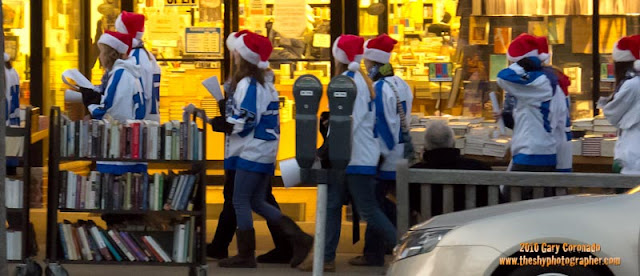 |
| Photo taken with Canon G12, ISO1600, f/4.5, 1/40s |
The holidays are here and you might be looking for something to give the significant photographer in your life. I would like to present here a list of things that you can give for every price range.
[Note that I am a bit biased here for the Canon brand because I am a Canon user. And also, I wouldn't recommend something I have not used, tried or tested so I wouldn't recommend cameras of another brand. If your photographer uses another brand, this is a good place to start since for most Canon brands, there is an equivalent from the other brands.]
Let's start with the camera. If the photographer in your life needs a new one then here are the choices for you.
If you want to splurge, then you can go for the
Canon 1D Mark IV
. But only if the photographer in your life had been really, REALLY nice. If not, then you can go for the
Canon 5D Mark II
or the
Canon 7D
. These are both professional bodies and no photographer would mind receiving either of these. The prosumer option is the
Canon 60D
while the consumer DSLR is the
Canon Rebel T2i
. These two can serve as a supplement to the pro-bodies your photographer already has. Note, though, that those last two cameras are no push-overs. They are also very capable cameras.
Another option is to give a point-and-shoot camera. There are a lot of options to choose from but I will start off with the top guns of point-and-shoots: the
Canon Powershot G12
and
Canon Powershot S95. These cameras have manual capabilities and will be a perfect compliment to your photographer's arsenal of DSLRs. What's more, these cameras shoot RAW, something any photographer would really want. At the opposite end of the spectrum, you can give a
Canon Powershot SD1400IS
or the
Canon Powershot SX210IS
. Though these do not shoot RAW they are still very capable cameras.
Next up are lenses. Lenses can go from relatively cheap to really expensive. One of the cheapest but really good lens to have is the
Canon EF 50mm f/1.8
, the so-called nifty-fifty. This lens is a very nice portrait lens. If your photographer has any of the APS-C cameras, like the
Canon 50D
, 60D, any of the Rebel Series, or the 7D, then you can get any of the EF-S lenses like the
Canon EF-S 17-85mm f/4-5.6
or the
Canon EF-S 60mm Macro
. If, on the other hand, the cameras on the arsenal are of the 5D and the 1D kind, then EF-S lenses won't work. Only EF lenses will work with those cameras, like the
Canon EF 28-135 f/3.5-5.6 IS USM
. Another one you can add on that list is the
Canon EF 70-300 f/4-5.6 IS
. But if you want to splurge then you can opt for the "luxury" lenses, like the
Canon EF 24-105 f/4L IS USM
or, the one I'd wish to receive myself, the
Canon EF 24-70 f/2.8 IS USM
. Note that all EF lenses will work for APS-C cameras.
External flash? You've got several choices, like the
Canon 580 EX II
and the
Canon 430 EX II, the big guns in the line up. Though those two will also work for the G12, the "official" partner of that camera is the
Canon 270 EX.
But of course, cameras won't work if there is no memory card inside. Depending on the camera model you can either get an
SD card
or a
CF card
. You can go really crazy even with these. Piece of advice, to get the most of the camera experience, you should get at least a "Class 4" card.
Next up are accessories. You can go for a backpack camera bag like the
Lowepro Fastpack 250
, a messenger bag like the
Tenba Messenger
, or something to house the Canon G12, like the
BlackRapid Snapr
. Want, in my opinion, the best the DSLR strap? Get the
BlackRapid RS5
.
A photographer cannot have enough tripods. In this category, the
Manfrotto 7303YB
. Another tripod option is something that can wrap around things like poles or tree limbs - the
Joby Gorillapod
plus
head
.
Pictures with the proper tint? The
ColorChecker Passport
can be a great help while the
Westcott Speedlite Kit is a good way to modify the light coming from your photographer's speedlites.
Photo editing? You can get
Photoshop Lightroom 3
,
Adobe Photoshop Elements 9
or splurge on
Adobe Photoshop CS5
. If your photographer is a Mac user, then you can also opt for
Apple Aperture
.
What photographer won't want to read books about photography. For this category, I recommend
Captured by the Light
,
Digital Photography Book
,
Studio and Location Lighting Secrets
,
Digital Photography Secrets
,
The Adobe Photoshop Lightroom 3 Book
, or
Layers: the Complete Guide to Photoshop's Most Powerful Features
.
Lastly, if you want to go for a little humor, and everyone can use a little bit of that, by giving your photographer
What the Duck
. Or what about a camera lens mug like the
Canon 24-105 lens replica
?
I hope this list will help you in choosing the best holiday gift for your photographer. Gook luck and have a Happy Holiday! :)



